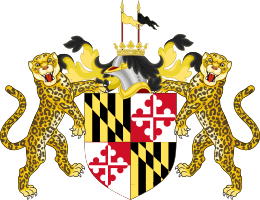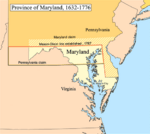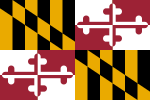Charles Calvert, 5th Baron Baltimore facts for kids
Quick facts for kids
The Lord Baltimore
|
|
|---|---|

Charles Calvert, 5th Baron Baltimore
|
|
| Lord of the Admiralty | |
| In office 1742–1744 |
|
| Succeeded by | Henry Bilson Legge |
| 6th Governor of Restored Proprietary Government | |
| In office 1732–1733 |
|
| Preceded by | Samuel Ogle |
| Succeeded by | Samuel Ogle |
| Personal details | |
| Born | 29 September 1699 England |
| Died | 24 April 1751 (aged 51) England |
| Spouse | Mary Janssen |
| Children | Frederick Calvert, 6th Baron Baltimore Caroline Eden Louisa Browning Benedict Swingate Calvert |
| Parents | Benedict Calvert, 4th Baron Baltimore Charlotte Lee, Lady Baltimore |
| Occupation | politician |
Charles Calvert, 5th Baron Baltimore (born September 29, 1699 – died April 24, 1751) was an important British nobleman. He was also the Proprietary Governor of the Province of Maryland. This meant his family owned and governed the colony.
Charles became the owner of Maryland when he was just fifteen years old. This happened after his father and grandfather passed away. The British King had given control of Maryland back to the Calvert family. They had lost it earlier in 1688. When Charles turned 21 in 1721, he took personal control of Maryland. He visited the colony briefly in 1732. For most of his life, Charles lived in England. There, he had a busy career in politics. He even became a Lord of the Admiralty, a high naval position, from 1742 to 1744. He passed away in England in 1751 when he was 52.
Contents
Early Life and Family History
Charles Calvert was born in England on September 29, 1699. He was the oldest son of Benedict Calvert, 4th Baron Baltimore. His mother was Charlotte Lee, Lady Baltimore. Charles's grandmother, Charlotte Lee, Countess of Lichfield, was a daughter of King Charles II of England.
The Calvert family had been Catholic for a long time. However, Charles's father, Benedict, decided to become Anglican. This was mainly for political reasons. After this, Charles also left his Jesuit school. He and his father then worshipped in the Church of England. Charles's grandfather, Charles Calvert, 3rd Baron Baltimore, remained Catholic until he died in 1715.
Charles Calvert's Political Career
Maryland's Ownership Restored
The Calvert family had lost control of the Province of Maryland in 1688. This happened during a big change in England called the Glorious Revolution. The British King took direct control of the colony.
In 1715, Charles's grandfather, Charles Calvert, 3rd Baron Baltimore, died. His title and claim to Maryland went to his son, Benedict Calvert, 4th Baron Baltimore. Benedict asked King George I of Great Britain to give the family's ownership of Maryland back. But Benedict died just two months later. So, the title and claim passed to his son, Charles.
At just fifteen years old, Charles Calvert was very lucky. The King decided to give the Calvert family's ownership of Maryland back to them. In 1721, Charles turned 21 and officially took control of Maryland. He chose his cousin, Captain Charles Calvert, to be the governor there.
Financial Challenges and New Governors
In 1722, Charles Calvert faced money problems. He sold his family's home, Kiplin Hall, for £7,000. This was a lot of money back then. Later, the University of Maryland bought it back as a historical site.
In 1727, Lord Baltimore appointed his brother, Benedict Leonard Calvert, as the new governor of Maryland. Benedict replaced their cousin, Captain Calvert. The change wasn't completely smooth. Captain Calvert wanted to keep half of a special tax on tobacco. This tax was meant for the governor. Benedict and their family in England were not happy about this. Lord Baltimore wrote that Benedict should get all the tax money.
Sadly, Benedict's health was not good. He died in 1732 while sailing back to England. Samuel Ogle became the new governor. During his time, Maryland had a border fight with Pennsylvania. People were taken prisoner, and there were riots. Governor Ogle asked the King for help.
Charles Travels to Maryland
Because of the border problems, Charles Calvert sailed to Maryland in 1732. He took charge of the colony himself for a short time. His main goal was to fix the dispute with Pennsylvania. He also wanted to deal with other important issues. There was violence on the border. Maryland loyalists, like Thomas Cresap, were fighting with Pennsylvanians.
Unfortunately, Charles made a mistake. He agreed to a border settlement with Pennsylvania using a map that was not correct. The map's measurements were wrong or missing. When Charles realized his mistake, he tried to cancel the agreement. But in 1735, the Penn family took him to court in London. The court case took a very long time. In 1750, the court decided that Pennsylvania was right. Charles's mistake meant Maryland lost about a thousand square miles of land to Pennsylvania.
Life Back in England
In 1732, Charles returned to England. He left Samuel Ogle in charge of Maryland again. Charles then had a successful career in English politics. He was a Fellow of the Royal Society, which means he was a member of a famous science group. He was also a friend of Frederick, Prince of Wales, who was the King's eldest son. Charles served as a Gentleman of the Bedchamber to the Prince of Wales from 1731 to 1747.
In 1739, he sailed on his new yacht, Augusta, to Russia. He represented the British Royal Family at a royal wedding there. This marriage was meant to make the relationship between the Russian and Austrian royal families stronger. It was a very grand event.
Charles was elected as a Member of Parliament (MP) for St Germains from 1734 to 1741. This was a "rotten borough," meaning it had very few voters but still had a representative. He was also an MP for Surrey from 1741 to 1751. He served as a Lord of the Admiralty from 1742 to 1744. From 1747 to 1751, he was the Surveyor-General of the Duchy of Cornwall. He also managed the Prince of Wales's household as Cofferer of the Household.
Charles could be an MP in the House of Commons because he held an Irish peerage. Irish peerages were titles that did not give a seat in the English House of Lords. This allowed people with these titles to serve in the House of Commons in London.
Family Life
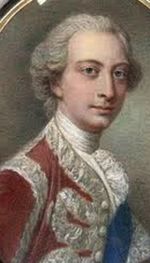
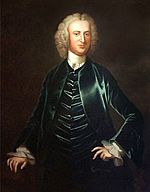
On July 20, 1730, Charles married Mary Janssen. She passed away in Paris in 1770. Mary was the daughter of Sir Theodore Janssen, 1st Baronet. Charles and Mary had three children:
- Frederick Calvert (born 1731 – died 1771) became the 6th and last Lord Baltimore after his father.
- Caroline Calvert (born around 1745) married Sir Robert Eden, 1st Baronet, of Maryland in 1763. He was the last colonial governor of Maryland. His rule ended during the American Revolution in 1774–1776.
- Louisa Calvert married John Browning. When her brother Frederick died in 1771, Louisa tried to claim ownership of Maryland. She believed she should inherit it instead of Frederick's son, Henry Harford. But before the court could decide, Maryland became part of the independent United States.
Charles also had a son named Benedict Swingate Calvert, born around 1730–1732. His mother's identity is not fully known. However, some believe she was a very important person in England. In 1742, when Benedict was about ten or twelve, he was sent to America. He was cared for by Dr. George H. Steuart, a doctor and friend of the Calvert family in Annapolis.
Woodcote Park Estate
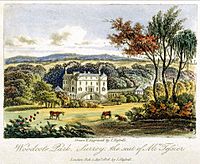
Charles lived with his family at Woodcote Park in Epsom, Surrey. This was a large estate built in the 1600s. Charles made many changes to the house. His brothers sometimes joked that he "pulled down everything" but "finished nothing."
Death and Lasting Impact
Charles Calvert died in 1751. His oldest son, Frederick Calvert, 6th Baron Baltimore, took over his title. Unlike his father, Frederick was not very interested in politics. He saw his lands, including Maryland, mostly as a way to get money. By 1776, Maryland was part of the American Revolution. The Calvert family then lost control of their colony forever.
Charles Calvert's portrait, along with those of other Barons Baltimore, can still be seen today. They hang in the Enoch Pratt Free Library in Baltimore. This city is named after his family.
The official flag of the State of Maryland is unique among the fifty states. It still shows the special design of the Barons Baltimore's family crest.
Charles County and Charles Street in Baltimore are named after Charles Calvert.


